Orc
Orcs are corrupt humanoid creatures, commonly found in service to Sauron or other warlords. In this game, they are a Shadow race, found in almost every Lord of the Rings TCG set and almost every Shadow culture. The majority of the minions in Moria,
Sauron, and
Orc cultures are orcs, and they also appear in
Isengard and
Wraith cultures. Orcs are versatile and have few particular unifying features across the race as a whole, tending to be more defined by their culture than their race. They range from small swarming minions (Goblin Runner (1U178)
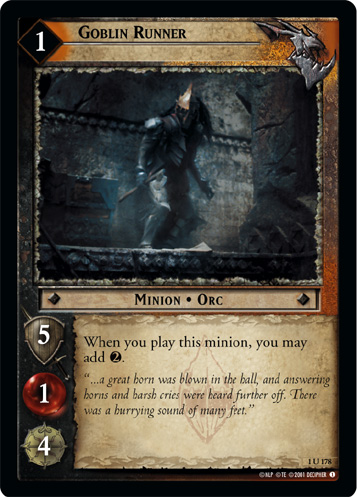 ) to large dangerous skirmishers (Host of Udûn (7U282)
) to large dangerous skirmishers (Host of Udûn (7U282)
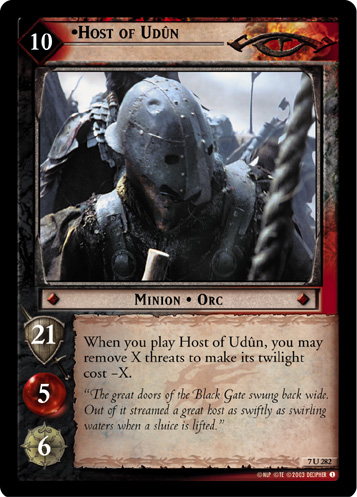 ).
).
The first cultures with orcs were Moria and
Sauron, introduced in the first set.
Moria goblin minions swarm the enemy with the help of conditions and hand weapons that draw more cards and play minions from the discard pile, sometimes supplementing these swarms with archery or a handful of stronger minions for beatdown.
Moria culture is synonymous with orcs: the only other minions in that culture are Cave Troll of Moria, Scourge of the Black Pit (1R165)
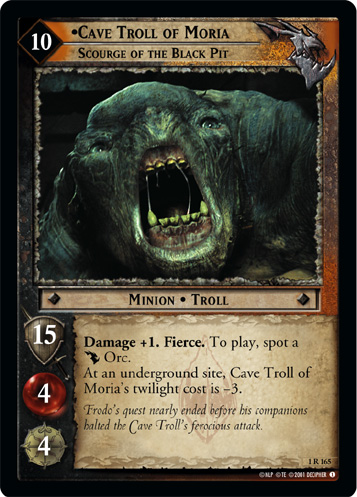 , two versions of Watcher in the Water, Keeper of Westgate (2R73)
, two versions of Watcher in the Water, Keeper of Westgate (2R73)
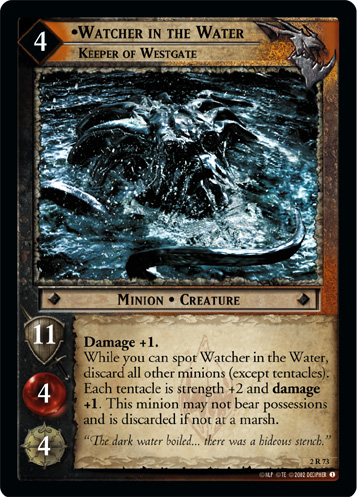 and its various Tentacles, and several versions of The Balrog.
and its various Tentacles, and several versions of The Balrog.
Sauron orcs are incredibly diverse: over the years their strategies have included direct wounding, corruption, discarding cards from the opponent's hand and milling their deck, grind strategies that slowly exhaust the Fellowship, Tracker orcs that reduce other orcs' site number or reduce the roaming penalty, generating threats and consuming them for other bonuses, buffing other roaming orcs, and Besiegers, who set up war engines, take control of sites, and stack orc minion cards on those sites after they're done skirmishing for various bonuses.
Sauron culture minions are mostly orcs but not entirely exclusively so. The other
Sauron minions are a handful of trolls and uruk-hai, The Mouth of Sauron, Lieutenant of Barad-dur (12R118)
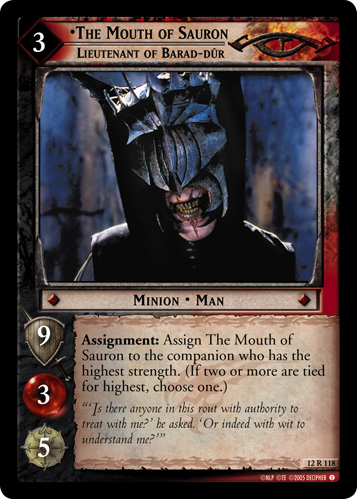 , and two versions of Sauron, The Lord of the Rings (9R+48)
, and two versions of Sauron, The Lord of the Rings (9R+48)
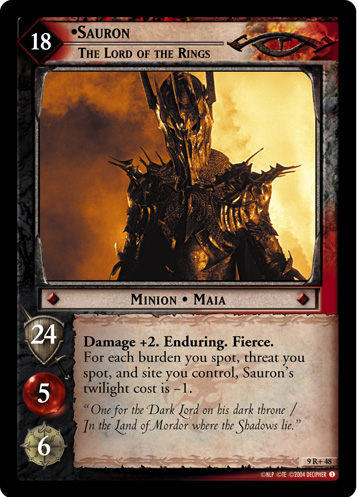 himself.
himself.
While Isengard culture initially focused on Saruman and Uruk-hai, the Realms of the Elf-lords introduced orcs to that culture.
Isengard orcs are not fearsome skirmishers, but if they survive to the Regroup Phase, they can exert or discard each other to exhaust or wound the Fellowship. The next set, Battle of Helm's Deep, introduced Warg-riders, Fierce orcs that use Warg mount possessions, although these lacked the lasting popularity of the previous type of
Isengard orcs. In general, when people refer to "Isengard Orcs" or "Isenorcs", they are referring to the swarming orcs with the Regroup Phase abilities.
The Return of the King introduced orcs to Wraith culture, featuring orcs from the army that marched out from Minas Morgul to storm Osgiliath. These orcs, also called "Morgul Orcs" or just "Morcs", work hand-in-gauntlet with Nazgul, rather than being as exclusive as subcultures in other cultures like
Isengard and
Raiders. Morcs spot wounds on the Ring-bearer, and generate, spot, and consume threats and burdens. Four
Wraith orc minions stand out in particular as commonly-played staples: Morgul Brute (7R188)
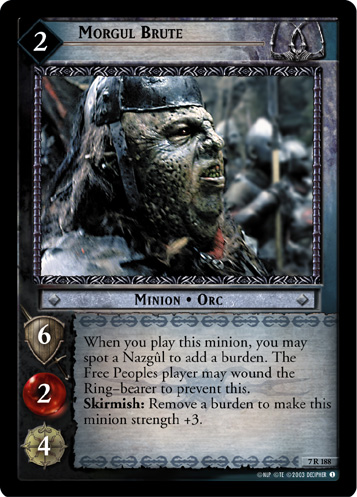 , Morgul Destroyer (7U190)
, Morgul Destroyer (7U190)
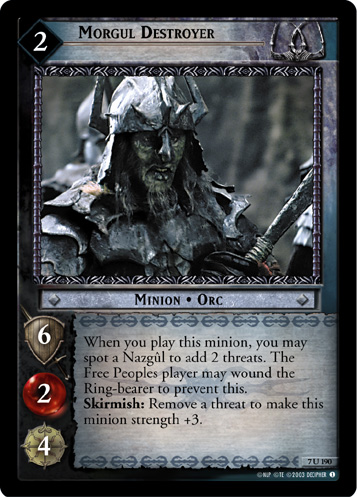 , Morgul Whelp (7U202)
, Morgul Whelp (7U202)
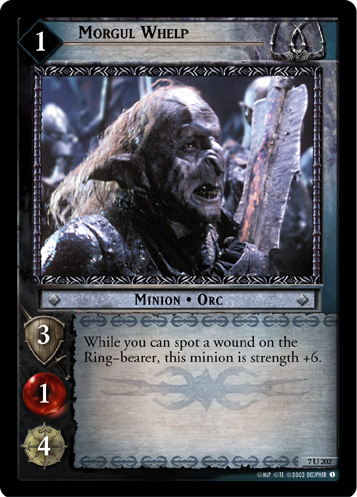 , and Morgul Squealer (8R77)
, and Morgul Squealer (8R77)
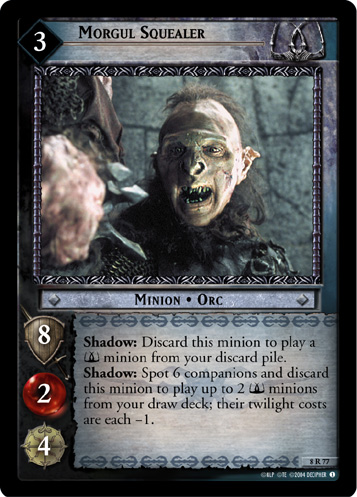 .
.
The 11th set, Shadows, reorganizes the Shadow cultures. In that set and all subsequent sets, all Orc minions are Orc culture, merging the goblin hordes of Moria, the orc workers of Isengard, and the orc armies of Sauron into a unified whole. Not all
Orc minions are orcs, however: that culture also includes the Cave Troll of Moria, Savage Menace (12R85)
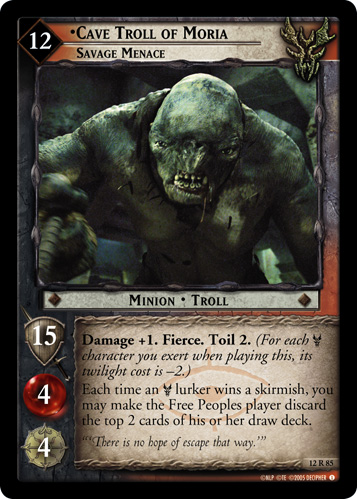 , the trolls of Sauron's armies, and two Half Trolls.
, the trolls of Sauron's armies, and two Half Trolls. Orc culture orcs are also incredibly diverse, with strategies including generating Twilight, exerting companions just by coming into play or being assigned to a skirmish, wounding companions skirmishing them, gaining bonuses from Underground sites, enabling swarms of trolls or swarming alongside trolls, recurring themselves, generating and consuming burdens, riding Warg mounts, Hunters who punish companions who aren't also hunters, and Lurkers who buff other orcs.
Orc culture is not necessarily synonymous with the orc race. Because orcs were split into two cultures from day one, few cards specify orcs in general; those that do, like Curse Their Foul Feet! (1R36)
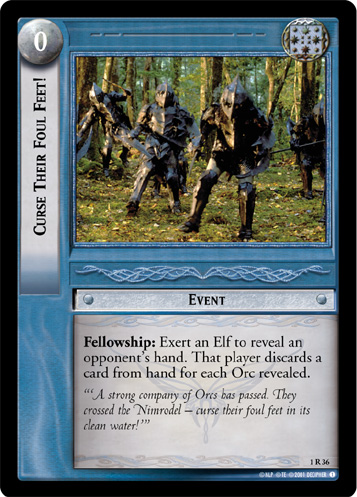 and Rúmil, Elven Protector (1U57)
and Rúmil, Elven Protector (1U57)
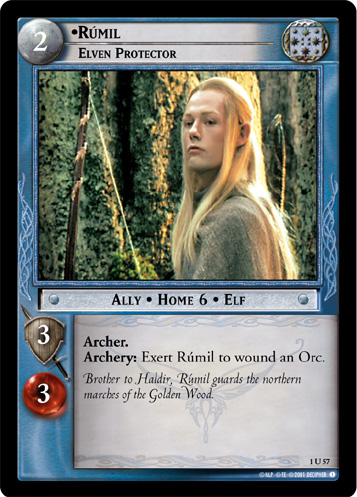 , affect orcs of any culture, but do not affect
, affect orcs of any culture, but do not affect Orc culture minions that are not orcs, like Mountain-troll (15R112)
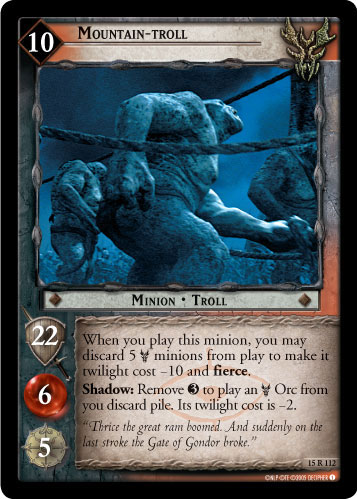 . Cards that specify
. Cards that specify minions, like Bound to its Fate (11U110)
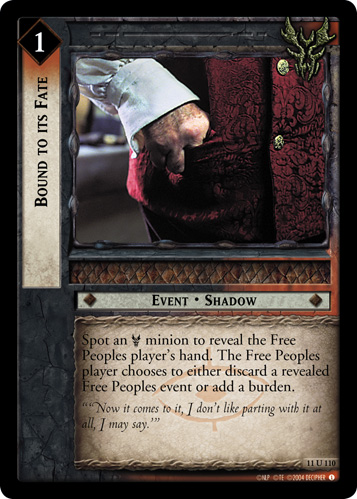 , would affect both Pitiless Orc (12U99)
, would affect both Pitiless Orc (12U99)
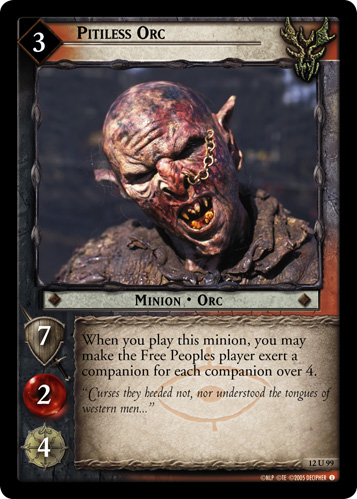 and Mountain-troll (15R112)
and Mountain-troll (15R112)
 but not orcs of other cultures, like Goblin Runner (1U178)
but not orcs of other cultures, like Goblin Runner (1U178)
 . A card that specifies
. A card that specifies Orcs, like Orc Hammer (11S130)
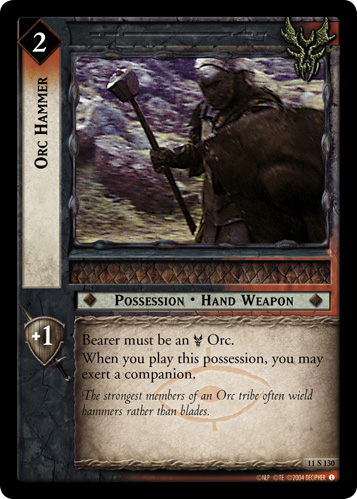 , only affects orcs of that culture: it would affect Pitiless Orc (12U99)
, only affects orcs of that culture: it would affect Pitiless Orc (12U99)
 , but not Mountain-troll (15R112)
, but not Mountain-troll (15R112)
 or Goblin Runner (1U178)
or Goblin Runner (1U178)
 .
.
While in many other fantasy settings goblins are separate from orcs, in both Lord of the Rings and this game, "goblin" simply refers to a stunted, numerous variety of orc. Cards like Goblin Runner (1U178)
 are orcs. However, while in Lord of the Rings Uruk-hai are a breed of orcs, in this game orcs and Uruk-hai are separate races, and cards that mention one do not affect the other.
are orcs. However, while in Lord of the Rings Uruk-hai are a breed of orcs, in this game orcs and Uruk-hai are separate races, and cards that mention one do not affect the other.
| Unloaded Keywords | ||
|---|---|---|
| Race | Decipher | [Raceless] • Balrog • Creature • Dwarf • Elf • Ent • Half-troll • Hobbit • Maia • Man • Nazgûl • Orc • Spider • Tree • Troll • Uruk-hai • Wizard • Wraith |
| Player's Council | Crow • Eagle | |
| Hobbit Draft Game | Bird • Dragon • Eagle • Giant • Goblin | |
| Site | ||
| Decipher | Battleground • Dwelling • Forest • Marsh • Mountain • Plains • River • Underground | |
| General | Decipher | Besieger • Corsair • Easterling • Engine • Fellowship • Fortification • Knight • Machine • Pipeweed • Ranger • Ring-bound • Search • Southron • Spell • Stealth • Tale • Tentacle • Tracker • Twilight • [Unbound] • Valiant • Villager • Weather • Warg-rider |
| Player's Council | Pony | |
| Hobbit Draft Game | Burglar • Cunning • Wise | |